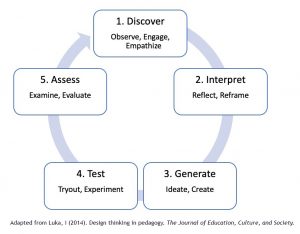Reimagining a Business Course Through a Cycle of Design Thinking
by Matt Connell
Program Director, Business Administration
with Diana LaRocco
Dean, School of Applied Liberal Arts and Social Sciences
Director, Goodwin University Institute for Learning Innovation
Sitting through my students’ final presentations for Business 150: Small Business and Entrepreneurship at Goodwin University, I found myself struggling to stay awake. I looked around the room, and it seemed like the students in the class were feeling the same. The only ones somewhat engaged were the individual presenters, and even they seemed like they were presenting something about which they knew little. Students were going through the motions, doing enough to meet the requirements of the assignment, but not achieving the intended outcomes of their oral presentations. They seemed to have gained little knowledge by completing this major assignment, which served as a summative assessment.
After the class, I sat back and thought, “What was the purpose of this assignment? What is this course supposed to accomplish? What is the goal?” — because whatever I just sat through was not it.
What this course is supposed to do is build students’ abilities to clearly articulate a self-identified business idea to others, verbally and in writing.
Those final presentations caused me to pause and reexamine the entire course, from the beginning through the final assessment. To do this, I engaged in a Cycle of Design Thinking.

I discovered that class time was largely spent reviewing the materials in the course text, going over items and topics that students could and should read about on their own. To create a self-identified business idea, weekly assignments required students to write one section of a conventional, multi-page business plan. At the end of each class, we had scheduled about 15 minutes for all students to “stand up and present” the business plan section for the week.
Interpreting and reframing what I had discovered, I identified flaws in the design and execution of various course components. It became apparent that my teaching methods and the structure of the assignments were inadvertently creating learning barriers for students. What I originally had in mind for the written assignment was an easy-to-understand executive summary of their business idea. Yet, the assignment I designed had students writing a full 30-page business plan. I wanted students to tell stories about their business ideas in a concise and engaging manner. I wanted them to be able to explain their plan to friends, family, and potential customers and investors. Unfortunately, I had not offered any in-class time for practice with feedback. It was only the last class in which they gave this type of presentation. Clearly, it was time for a revamp.
Using the Universal Design for Learning (UDL) framework as a lens, I generated several ideas that I then tested. All in all, it was apparent that I was not supporting students to pursue mastery. So, I started by applying concepts outlined in the UDL checkpoint increase mastery-oriented feedback. I decided to provide students with class time each week to actively enage in discussions about their business ideas and to work through details.
In this reimagined model, students talk through various aspects of their business plans and practice “pitching” their ideas. They receive real-time constructive feedback from their peers and me on their plans and on how to tell their stories better and more authentically. Students incorporate feedback into the next week’s presentations. To accommodate the class time required to do all this, I moved to a flipped learning approach in which students read, watch, or otherwise actively take in and engage with assigned materials before the class.
My reflections on and assessment of these changes point to substantial improvements in students’ final presentations. Students now hand in a short executive summary and have three minutes to present their business idea.
Perhaps most importantly, classmates are awake and visibly engaged, as am I.
Learn more about the Business Administration programs at Goodwin University.
Matt Connell is an assistant professor in the Business Administration program at Goodwin University and currently serves as the program director. He earned a bachelor’s degree in Business from Evergreen State College, a master’s degree in Special Education from St. Joseph College, a doctorate in Educational Leadership from the University of Hartford, and an MBA from the University of Connecticut. His doctoral studies focused on Group Emotional Intelligence and its effect on organizations.

